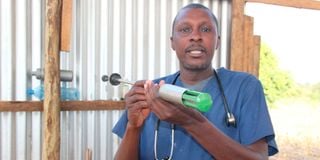Call me if your cow swallows nail or wire

Dr Bonface Mwaniki with a magnet gun.
When feeding, domestic animals can swallow metals and other objects that are harmful to their health. Gitonga Marete spoke to Bonface Mwaniki, a practising veterinary doctor and surgeon with more than 20 years’ experience. Dr Mwaniki is based in upper eastern Kenya but is only a phone call away from you.
Apart from the conventional animal diseases, what others should a farmer look out for and what are their causes?
Hardware diseases occur when an animal ingests metals and other alien materials. This happens only to ruminants like cows, sheep and goats – animals that do not chew food like we do but just swallow.
The animals have four stomach chambers – the rumen, reticulum, omasum and abomasum.
Every chamber performs a specific function in digestion.
How do the metals cause diseases?
Let’s talk about dairy cows because this is where hardware diseases are common. The swallowed fodder moves from one chamber to the other through contractions. The second chamber, the reticulum, is where fodder is digested and moves into the omasum in form of fluid.
Due to the way we handle fodder, it is easy for foreign a material to find its way there. These are deposited in the reticulum.
When and how is the danger?
During pregnancy, the foetus in the womb pushes the compartments to a constrained position and limits space. The reticulum, where these metals are deposited, borders key body organs like the heart and lungs. By the time the cow is seven or eight months pregnant, there little space.
If there is a sharp object in the animal, it pierces the wall of the reticulum and the diaphragm, which protects the lungs, introducing bacteria into the organ.
This sounds complex.
Digestion involves different types of bacteria that are in the four stomach chambers. Once the membrane is punctured, the bacteria move to the lungs or heart and cause infections.
It causes pneumonia in lungs. Farmers keep complaining of pneumonia in their dairy animals that does not respond to treatment. This because the bacteria is always being deposited there.
How are hardware diseases diagnosed?
When pneumonia appears not to be healing even after a cow is treated, that could be the problem.
If the infection is in the heart, the animal walks painfully, grunting and with a hunched back.
The rumen stops working, resulting in other complications like constipation. For lung infection, the cow dies within two months but death is in days if the heart is involved. If the problem is in the heart, the jugular vein swells. There is also fever. For lungs, there is breathing difficulty.
How can hardware diseases be prevented or cured? When does one resort to surgery?
We have been sensitising farmers on these illnesses. Since you cannot stop a cow from swallowing metals, the solution is to insert a magnate in the reticulum. This ensure the sharp objects are far from the stomach walls.
If a hardware disease is diagnosed early, the solution is to remove the metal through surgery. The operation takes a maximum of three hours. We sedate the area to be operated, with the animal standing.
Antibiotics are administered and the animal heals in three days to a week. I have removed nails, wires and even plastics from the stomachs of cows.
Take us through this magnet therapy.
We use a magnet gun to ensure it is deposited in the right position. The procedure takes about 10 minutes and costs less than Sh2,000. The magnet – which is cylindrical, weighs 100g and is 9.5x3.5cm. It is inserted in a mature cow of about 300 kilos. It remains there for as long as the animal is alive. Surprisingly, some of these metals are digested while on the magnet.
How prevalent are hardware diseases?
In this region, some 90 per cent of dairy cows’ mortality is because of hardware diseases. I came to this conclusion, based on the post-mortem results on insured cows. The problem occurs mainly in cows during pregnancy or when calving down.
Unfortunately, most farmers don’t opt for post-mortem when a cow dies. They bury the carcass hurriedly. It is important that farmers establish what killed their animals so as to take preventive measures.
Magnets sound the right. Why haven’t many Kenyan farmers embraced this therapy?
Most are not aware and we are sensitising them on post-mortem. There is also the notion that the animal will not be safe with a foreign object in the stomach. We ask farmers: ‘what is better – an object whose position you know and which helps in trapping the dangerous metals or the wires and nails that harm the animal?’
Suppose a cow with a chronic infection swallows a metal?
We usually advise farmers to stop the antibacterial treatment and prepare to slaughter the animal for meat as there is no other option.
How did you get into dairy farming?
When I started practising, I realised that there was need to be practical. I set up a veterinary shop to supply quality medicine and feeds to farmers. Recently, I established a dairy venture. My four cows produce an average of 130 litres of milk a day. This is where I take farmers for practical lessons.
Your parting shot?
Farmers lose hundreds of dairy cows every year to hardware diseases. If you vaccinate animals against foot and mouth disease, then the magnet should be the vaccination against hardware illnesses.





